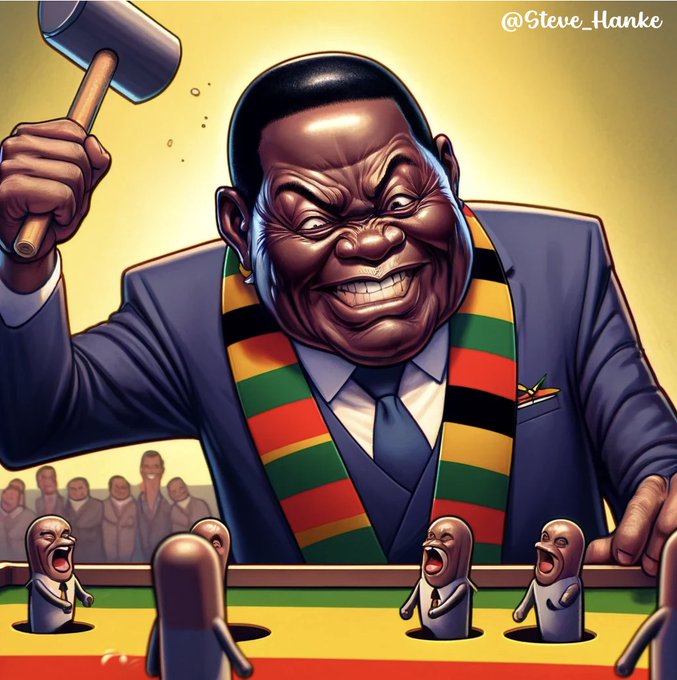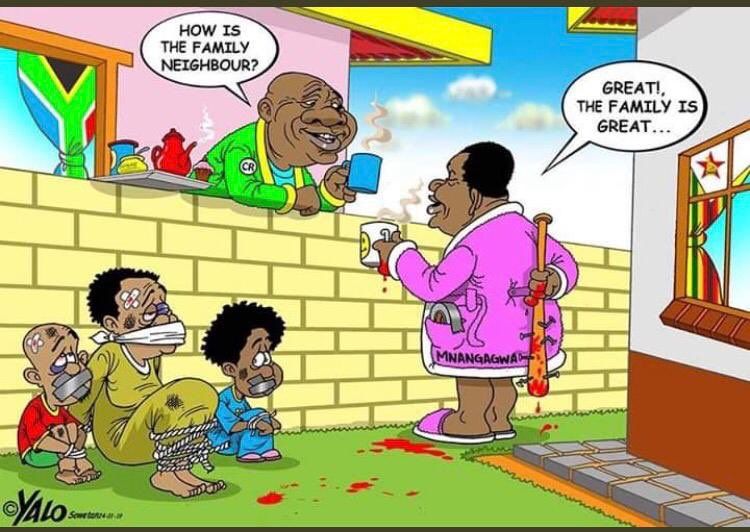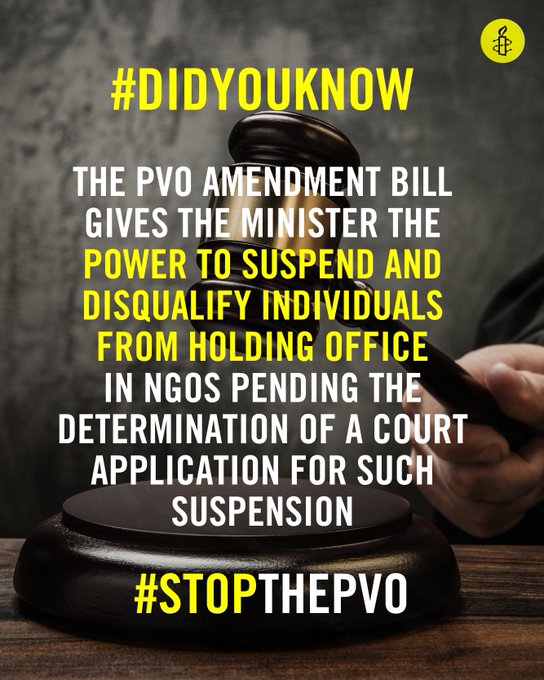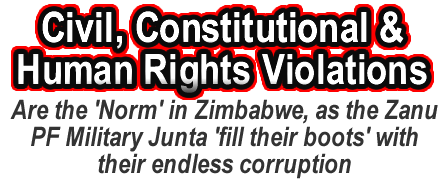Home
19th July 2024 - Zanu PF Must Go
- Details
- Written by: John C Burke
- Hits: 42
 TO THE NEWLY ELECTED GOVERNMENT, fao Sir Keir Starmer; PRIME MINISTER OF THE UK
TO THE NEWLY ELECTED GOVERNMENT, fao Sir Keir Starmer; PRIME MINISTER OF THE UK
THE ONGOING CONSTITUTIONAL INJUSTICE, INCACERATION OF THE OPPOSITION MEMBERS ALIGNED TO ADVOCATE NELSON CHAMISA, AND ABUSE OF HUMAN RIGHTS.
We, as the Zimbabwean diaspora, have written several petitions to the UK government {including the FCDO} and carried out various protests in the UK against the Zanu-PF regime in Zimbabwe. Which we feel have illegally and unconstitutionally declared itself as the elected government of Zimbabwe. With ED Mnangagwa as their {illegal} President!
Emmerson Mnangagwa, the current President of Zimbabwe, has been accused of using various tactics to maintain power and suppress opposition, including:
- Coercion and intimidation: Using security forces to silence political opponents and critics.
- Propaganda and disinformation: Controlling state media to spread false information and propaganda.
- Repression of dissent: Cracking down on protests and demonstrations, often with violence.
- Patronage and clientelism: Rewarding loyalists with government positions and resources.
- Electoral manipulation: Allegedly rigging elections to maintain power.
- Divisive politics: Using ethnic and regional divisions to consolidate power.
- Corruption and cronyism: Accused of enriching himself and allies through corrupt means.
- Surveillance and infiltration: Infiltrating opposition parties and civil society organizations.
- Lawfare: Using the legal system to silence opponents and critics.
- Charm offensive: Presenting himself as a reformer and democrat to international audiences.
These tactics have been criticized by opposition parties, civil society, and international observers, who accuse Mnangagwa of undermining democracy and human rights in Zimbabwe.
Indeed, the failure to respect the voting intentions of the Zimbabwean people, in the {highly disputed} elections carried out over 23-24th August 2023 – but the Zimbabwe Electoral Commission {ZEC} have never declared the voting numbers to this date, they simply claimed that Mnangagwa had “won” with 54% of the total vote.
Zim Democracy Finally DEAD
- Details
- Written by: 30th May Petition Group
- Hits: 118
 In the Chinese Built (!!) Parliament Building the (false) Leader of The House, appointed the (Zanu PF stooge) TSHABANGU as ‘Leader of the Opposition’. Thus now a 100% Zanu PF controlled Parliament. This despite millions of votes for CCC MP’s on 23-24th August 2023 - which now count for nothing, zero, zilch! The election was a pointless charade! A slap in the face to all those who struggled (and those that died) trying to cast their Democratically and Constitutionally Mandated VOTE.
In the Chinese Built (!!) Parliament Building the (false) Leader of The House, appointed the (Zanu PF stooge) TSHABANGU as ‘Leader of the Opposition’. Thus now a 100% Zanu PF controlled Parliament. This despite millions of votes for CCC MP’s on 23-24th August 2023 - which now count for nothing, zero, zilch! The election was a pointless charade! A slap in the face to all those who struggled (and those that died) trying to cast their Democratically and Constitutionally Mandated VOTE.
From the X/Twitter Post of David Coltart {Made on 31st May 2024} he eloquently makes the point that the “declaration” by the (corrupted) Leader of the House (Parliament) cannot be accepted. Otherwise there is a De facto “ONE PARTY STATE IN ZIMBABWE”
“”I am appalled by the statement made by the Speaker of Parliament yesterday that Mr Tshabangu has been recognised as the leader of the Opposition in Parliament. In my view this act is in fact contemptuous of Parliament itself.””
- "At their core all Parliaments throughout the world are meant to be representative institutions. They have been established to give the public a voice. The whole purpose of elections is to ensure that elected MPs can enunciate the concerns and issues of those who elected them. This is the very essence of representative democracy. It follows that the leader of the Opposition must be a person who clearly represents the interests of citizens who oppose the government of the day and who has been clearly chosen by them, either directly or indirectly, to lead them in Parliament."
Injustice in Zimbabwe
- Details
- Written by: Basil Kamombe
- Hits: 166
 Zimbabwe has turned into a full blown banana republic because of one man holding the country hostage with his authoritarianism as if he is even above the constitution himself. Mnangagwa has done worse in a short period of time he has ruled Zimbabwe, from seeing the tanks rolling in the streets of Harare for the first time on August 2018.
Zimbabwe has turned into a full blown banana republic because of one man holding the country hostage with his authoritarianism as if he is even above the constitution himself. Mnangagwa has done worse in a short period of time he has ruled Zimbabwe, from seeing the tanks rolling in the streets of Harare for the first time on August 2018.
On the 30th of May 2024 he appeared at an event in Chikomba where he openly acknowledged a slogan that he will be ruling in 2030. What does the constitution say? According to section 91(2) of the constitution: “A person is disqualified for election as President or appointment as Vice-President if he or she has already held office as President for two terms, whether continuous or not, and for the purpose of this subsection three or more years is deemed to be a full term.”
By 2028 the President would have served his two terms so he will not be eligible to stand as President or Vice President. However, we are likely to see the President going further his term but as the Zimbabweans in the Diaspora we have organised to seek the international intervention through petitioning relevant organisations to stop the constitutional injustice.
I was part of the organising team in the UK that wants to see reversals and changing of the worst laws created by Mnangagwa, We held a successful demonstration, handing over the petition to PM at 10 Downing Street on the 30th of May 2024. Joining myself in organising was John Burke of ZHRO, supporting the 5 other petitioners; Ronald Mutumbi, Michelle Nokuthaba Mpofu, Greatman Makipa, Diana Machingauta, Christian Tendai Mapfumo. Also joining were other Zimbabwean Activists who want this abuse of law, human rights, and violence to stop in Zimbabwe. These were included Xoliso Sithole, Vengai Mutsawu, Evelyn Chigaro; Dickson Chikwizo; Mashama P Mause; Jane Mundangedfupse; Xoliso Sithole; Tryness Ncube; Sibangani Sibanda; Kelvin Mhlanga; Pelly Ziramba; Josephine Jenje; Chido Shamu; Xolisani Masuku and Johnson Bhila
 What happens next? Petitioning other foreign offices in the UK, and the new PM or the government after July 4th 2024, holding protests the same time the SADC Summit is taking place in Harare in August as we are concerned on the ‘deaf ear’ which SADC has turned to solve the crisis in Zimbabwe. Or perhaps, we could say the whole SADC was bribed by Mnangagwa as we have heard allegations that the ANC party in South Africa was given a token of $3 million for the elections.
What happens next? Petitioning other foreign offices in the UK, and the new PM or the government after July 4th 2024, holding protests the same time the SADC Summit is taking place in Harare in August as we are concerned on the ‘deaf ear’ which SADC has turned to solve the crisis in Zimbabwe. Or perhaps, we could say the whole SADC was bribed by Mnangagwa as we have heard allegations that the ANC party in South Africa was given a token of $3 million for the elections.
If Mnangagwa extends his term until 2030 it is likely he will go beyond that and his two terms has been disastrous with creating a parliamentary ‘crime scene’, introducing the Patriotic Act which is already law and soon to sign the PVO Bill just to suppress Human Rights Activists and Citizens.
Will Mnangagwa succeed in amending the Constitution? It is evident he will, but however if he succeeds in amending the constitution the amendment will not apply to Mnangagwa. Section 328(7) was designed to make it difficult for Presidents to extend their terms of office:
“Notwithstanding any other provision of this section, an amendment to a term-limit provision.[Note: section 91(2) is a term-limit provision] the effect of which is to extend the length of time that a person may hold or occupy any public office, does not apply in relation to any person who held or occupied that office, at any time before the amendment.”
We have seen the PVO hearings, violence took place, no one was allowed to object as the Zanu-PF youths were brought in, to ‘support’ this bill. Myself and ZHRO have written abount the PVO Bill and its implication for opponents of the Zimbabwe regime {Zanu PF - effectively now a "One Party State"} See below for links to previous information;
Constitutional Injustice
- Details
- Written by: Basil Kamombe, Moses Mbano and John Burke
- Hits: 277
 UPDATE: Demo and Petition confirmed by Diplomatic Police Unit for 14:00 on Thursday 30th May 2024.
UPDATE: Demo and Petition confirmed by Diplomatic Police Unit for 14:00 on Thursday 30th May 2024.
**This will be subject to the UK Prime Minister, Rishi Sunak, calling for a General Election NOW CONFIRMED for 4th July 2024, and thus drastically increasing the 'activity' around 10 Downing Street including a "media circus" of reporters and photographers in the next week or so. Therefore we have also alerted the Zimbabwe Desk at the FCDO to receive the Petition as well.

AS ZIMBABWEANS BASED ACTIVISTS IN THE UK PLAN FOR A DEMONSTRATION IN LONDON, UK.
The Zimbabwean President must not sign the new law proposed; which is the PVO Private Voluntary Organisation Amendment Bill. #STOPPVOBILL
Responding to the PVO hearings which took place last week in Zimbabwe, Basil Kamombe a UK based Activist has condemned the violence which likely shows that a number of people present were bussed-in by Zanu-PF ‘elites’ and politicians. Cases of violence were recorded during the hearings.
“This bill is disastrous and especially a time where the Zimbabwean government is just passing laws that are shrinking the democratic space in Zimbabwe.”
How would something that likely benefit the country, but have a group of people singing
“Asingade ngaabude muZimbabwe” meaning if you don’t, want leave Zimbabwe or slogans like “tengesa uone mashura” (sellout and see what happens) it is the language of Zanu-PF and the language of violence to instil fear to those against the Bill,”
We managed to track down other Activists who have joined hands to organise a number of demonstrations in London including petitions for the international community to see the injustice of the constitution taking place in Zimbabwe. Greatman Makipa shared his concern on the impact of the PVO Bill on how it will be made difficult for Human Rights Organisations to be registered in Zimbabwe, ZHRO also expressed their concern as the support coming through for development fund in Zimbabwe is close to a billion dollars and Zimbabwe will likely lose all that funding because of this absurd law if it is passed, these organisations have been helping the lives of many Zimbabweans since the government does no little help to its own citizens.
Ronald Mutumbi also made his comment on how about 4 members of the CCC were arrested in Masvingo for disrupting PVO Bill hearings of which the Zanu-PF youth militia, who are the real culprits, are walking scot free. It is evident that the Bill itself is a ‘criminal’ bill to the Citizens who are already suffering in the hands of the regime. As part of the demonstration we have Human Rights Activists who will be joining in who shared their concern over the ongoing constitution injustice in Zimbabwe.
Like Michelle Nokuthaba Mpofu, Diana Machingauta, Tendai Christian Mapfumo, Xoliso Sithole, Simbarashe Jingo, who are based in the UK who are fearlessly speaking out against the regime which is endangering their lives. We also saw Job Sikhala was threatened last week with Zanu-PF government to charge him with the Patriotic Act after speaking at the Human Rights Summit in Geneva, Switzerland.
Page 1 of 10
